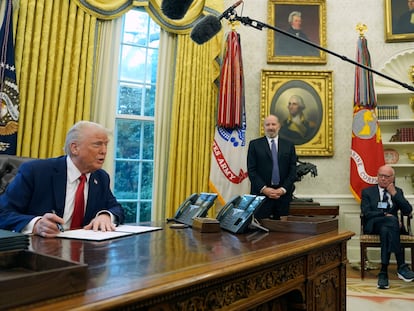Who do tariffs affect? How do they work? Trump’s tariffs explained in charts
The US is imposing new levies on countries from which it buys everything from cars to fruit and vegetables. Until now, the cost of similar measures has been paid by American consumers

The tariffs on imports from China implemented by Donald Trump on Saturday came into effect on Tuesday. Those on Canada and Mexico were suspended for a month after a last-minute agreement. The measure threatens the three countries with which the United States trades the most, and forms the basis of the president’s economic policy despite the fact that these levies have for years been considered obsolete and counterproductive for national economies and the global free trade market.
Below we review some data that helps to understand the importance and potential scope of the first round of tariffs of Trump’s second term in office.
The United States imports a lot and this figure is growing. It is the country that imports the most goods and services and, in absolute terms, it adds up to almost as much as the other four largest importers in the world combined (Germany, the United Kingdom, France and Japan). Imports account for 12% of its gross domestic product and they are growing faster than its exports.
Trump’s tariffs hit the countries from which the US imports the most. These types of taxes are used, in theory, to protect the domestic production of a product. They are expressed as a percentage of the sale price and are usually paid by the importer directly at customs. A practical case: the European Union established tariffs on electric cars manufactured in China and subsidized by the local government, including a 7.8% tax on Tesla cars. If a car costs €30,000, the dealer who brings it to Europe will pay an extra €2,340 in tariffs (in addition to other expenses). In order not to lose money, it will have to pass on this cost to the buyer, who will end up paying more. (Elon Musk himself, owner of Tesla, has taken the EU to court for this reason.)
Trump has tried to apply this logic to the three countries from which he has imported the most products in the last 20 years.
The new tariffs affect the goods that the United States imports the most. The main goods that the country buys from abroad are cars (45% of everything that it buys), pharmaceuticals (30%), oil (25%), mobile phones and fruit (14%). As can be seen in the following graph, most of these products come from the very same countries on which the U.S. is imposing tariffs.
Mexico is the main source of the auto industry in the United States: in 2023, it was at the origin of two out of every five imported vehicles, auto parts and motors. And one out of every two vegetables and fruits. Looking at each product, 60% of strawberries, peppers, cucumbers and carrots come from Mexico.
Canada, for its part, is the main exporter of crude oil to the U.S. (contrary to what the Americans believe, according to a recent survey) and China is the main exporter of electric batteries and mobile phones.
Tariffs have been declining for decades. Trump’s measure goes against global trends and those of the country itself. Currently, the average tariff in the United States is 2.5%, lower than in other countries. With free trade agreements, there are also many products exempt from taxes.
Trump already proposed tariffs in 2020, Biden kept the majority of them, and they were expensive. Trump’s tariffs in 2018 proved costly for consumers and producers. Tariffs of more than 25% on products such as steel, washing machines and solar panels represented the most protectionist policy since 1930. There was no evidence that they helped bring back American manufacturing jobs or had any impact on the industry, according to a study published in the Harvard Business Review.
Biden left in place most of these measures and deepened those affecting Chinese products (in addition to suspending the export of chips in 2022). To avoid disagreements with the European Union, he decided to suspend most of the tariffs on European countries for five years.
In the years of the so-called “Trade War”, the tariff war that Trump started during his first term, it was mainly Americans who lost out. According to the American think tank Tax Foundation, the cost that consumers had to pay extra due to higher prices (a consequence of tariffs) exceeded $300 per household.
Another desired effect of the tariffs, namely that American companies manufacturing in China would return to the United States, did not take place either: industry analysts indicate that those that left Beijing established themselves in other Asian countries such as Vietnam and Malaysia.
Meanwhile China’s retaliatory 25 percent tariffs have hit American agriculture hard, with the country being the largest U.S. market for corn, wheat, soybeans, pork and beef exports.
Trump’s new tariffs will be even more expensive. The tariffs Trump is now proposing are general, with the exception of Canadian energy products, which are taxed at 10%. But he has not chosen to tax a specific product that could favor local production or with the idea of protecting the poorest consumers.
Without such a specific policy, the cost will immediately impact consumers. Specifically, according to an analysis by the Tax Foundation, tariffs will cost at least $830 per household in 2025, almost three times what they have cost until now. In addition, they will have a negative impact on the country's GDP (down 0.4%).
For Canada and Mexico, exporting less would be a problem. Mexico is highly dependent on the United States for trade, which is the recipient of 83% of all its exports. For some specific products, the supply rises to 90%, as in the case of avocados.
Canada is a similar case: 77% of the country’s exports are destined for the United States and, in fact, it is the main energy supplier for Americans.
Canada has announced retaliation in the form of tariffs on products it imports from the United States (such as liquor). Colombia tried the same before agreeing last week to accept more migrant repatriation flights.
A look at the data on what Canada or Colombia import from the U.S. evidences the inequality, in terms of the size of the trade flow, of this war. In Canada, 18% of imports come from the United States (compared to 77% of what Washington buys from Canada) and in Colombia, just 0.5%.
It remains to be seen whether there will be exceptions for certain products this time. In the previous round of tariffs, exemptions were negotiated for Apple: it was agreed that raising the price of the iPhone would make it less competitive compared to other foreign brands such as South Korea's Samsung.
What about Europe? Trump has made it clear that no country will be exempt from tariffs and on February 18 he intends to implement another round to include new countries. He has highlighted the trade deficit, meaning that the United States buys more from the EU than it sells to it: measured as a whole, the European Union is the place from which the United States imports the most. According to Trump, this makes Americans “lose money” compared to other partners (the United States has had a negative global trade balance since the 1970s and this is not a problem per se, as many economists have pointed out).
The United States accounts for around 13% of what the European Union buys from abroad and it is the country from which it imports the most energy products (gas and oil): 15%.
Sign up for our weekly newsletter to get more English-language news coverage from EL PAÍS USA Edition
Tu suscripción se está usando en otro dispositivo
¿Quieres añadir otro usuario a tu suscripción?
Si continúas leyendo en este dispositivo, no se podrá leer en el otro.
FlechaTu suscripción se está usando en otro dispositivo y solo puedes acceder a EL PAÍS desde un dispositivo a la vez.
Si quieres compartir tu cuenta, cambia tu suscripción a la modalidad Premium, así podrás añadir otro usuario. Cada uno accederá con su propia cuenta de email, lo que os permitirá personalizar vuestra experiencia en EL PAÍS.
¿Tienes una suscripción de empresa? Accede aquí para contratar más cuentas.
En el caso de no saber quién está usando tu cuenta, te recomendamos cambiar tu contraseña aquí.
Si decides continuar compartiendo tu cuenta, este mensaje se mostrará en tu dispositivo y en el de la otra persona que está usando tu cuenta de forma indefinida, afectando a tu experiencia de lectura. Puedes consultar aquí los términos y condiciones de la suscripción digital.
More information
Archived In
Últimas noticias
All the effects of gentrification in one corner of Mexico’s Colonia Roma
Palestinian reporter Youmna El Sayed: ‘My family told me I had to choose between being a journalist or a mother’
The new language of the workplace: Knowing how to ask AI questions is more important than using it
Russell Tovey: ‘I was advised many times not to come out, I don’t think there was many people who’d done that — and I feel really proud that I’m one of those that did’
Most viewed
- Christian Louboutin: ‘Young people don’t want to be like their parents. And if their parents wear sneakers, they’re going to look for something else’
- The low-cost creative revolution: How technology is making art accessible to everyone
- US sanctions against jailed cartel leader ‘El Marro’ highlight Mexico’s lack of control over its prisons
- Liset Menéndez de la Prida, neuroscientist: ‘It’s not normal to constantly seek pleasure; it’s important to be bored, to be calm’
- Cartels in Mexico take a leap forward with narco-drones: ‘It is criminal groups that are leading the innovation race’










































